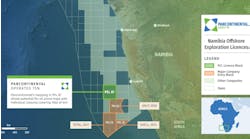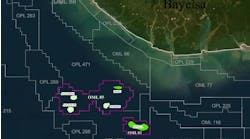Offshore staff
PERTH, Australia – Carnarvon Petroleum has acquired 100% of the WA-523-P exploration permit offshore Western Australia.
Managing director and CEO Adrian Cook said: “This area of the North West Shelf has tremendous opportunity …the mapped prospectivity in this proven oil province, and within the permit, has outstanding development potential.
“We believe we can generate significant shareholder value by applying cutting edge seismic imaging technologies which have recently proven successful in our Phoenix permits. These modern processes will provide a step-change improvement in the definition of prospects, determination of volumes, and reduction of drilling risk.”
Carnarvon’s work program comprises reprocessing existing3D seismic data and interpretation and analysis of the results within the initial three-year term.
Reprocessing is under way and should take 12 months to complete. If the data looks positive, the company may decide to acquire new 3D seismic and drill a well over the course of the following three years.
The new permit, covering roughly 4,220 sq km (1,629 sq mi), is in the northernmost extent of Western Australian waters. It includes theBuffalo oil field and the undeveloped Bluff-1 and Buller-1 oil discoveries, and is also close to the Laminaria, Corallina, Kitan, Jahal, and Kuda Tasi field that collectively contain around 280 MMbbl initially recoverable.
To the south is theBayu-Undan gas/condensate field, while the Kakatua and Elang oil fields are 25-40 km (15.5-25 mi) to the east.
Buffalo, discovered in 1996 in 27 m (88.6 m) of water, produced around 20 MMbbl of high-quality oil before operations ceased in 2004. Depending on the oil price and re-mapping of the field, Carnarvon says re-development could be an option, perhaps via a tieback to nearby facilities.
Regionally, the absence of accurate seismic depth imaging of the target reservoirs has resulted in a poor track record for well depths “coming in on prognosis,” even when drilled close to existing well control.
This issue with depth mapping right, the company says, has hampered definition of field development locations and prospects, describing volumes, reducing risk and justifying drilling.
Carnarvon’s proposed new seismic imaging processes will address these challenges by employing more modern processes that it has tested on its other permits.
Over the past three years, advances in computing technology have greatly expanded geophysical capabilities. For the WA-523-P seismic, one critical factor could be the recent emergence of full waveform inversion to provide the higher resolution velocity field measurement needed for input to pre-stack depth migration, and to provide the required improved depth imaging.
05/31/2016
Share your news withOffshore at [email protected]


